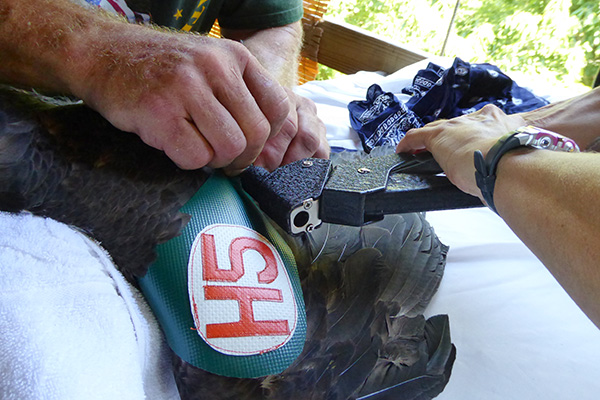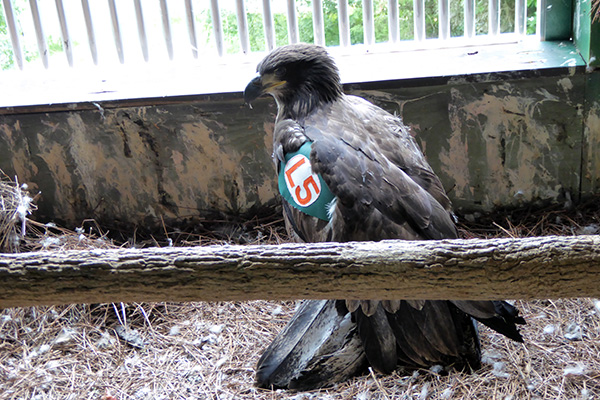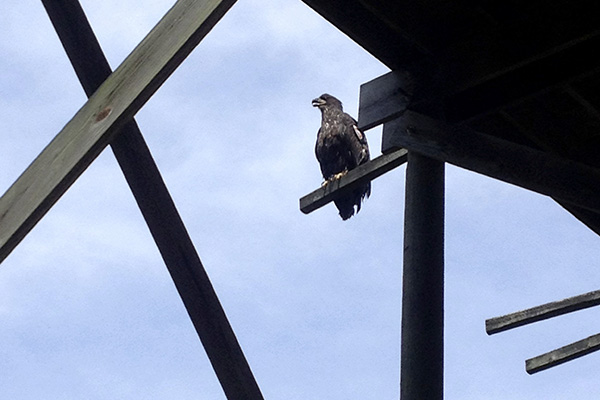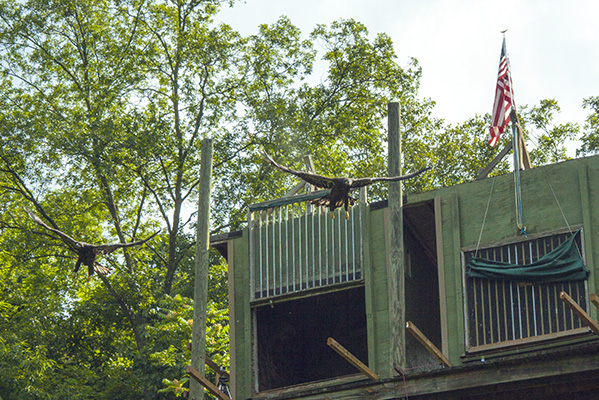Eagle Hacking
AEF’s Hacking program resulted in the the release of 182 young bald eagles and 11 golden eagles into the foothills of the Great Smoky Mountains in East Tennessee from 1992 through 2020.
Once an eaglet hatched at AEF reached 6-8 weeks of age, it graduated to our Hack Tower on Douglas Lake in East Tennessee to prepare for its release into the wild.
In addition, AEF often received eaglets from other organizations that did not have their own release facility. We also received eaglets that had fallen out of their nests in the wild, AEF was able to care for or rehabilitate the young birds until they were able to be released or we provided a forever home for them if they sustained injuries which rendered them non-releasable.
AEF even rescued bald eagle eggs from potentially dangerous nesting sites (such as a lighting tower in a professional baseball park), and brought them safely back to our incubators, caring for them diligently, and ultimately releasing them into the wild.
What is Hacking?
Hacking is a controlled way to raise and release bald eagles into a wild viable environment from a artificial nesting tower. This method is used to simulate a wild eagle nesting site and aids in recovery in an area where re-population is desirable.
The principle behind eagle hacking is that eagles tend to return to their natal nesting area from which they were raised and fledged (within approximately 75 miles) after they reach sexual maturity at 4 to 5 years age and choose a lifelong mate.
AEF Hack Tower Description
The Douglas Lake Hack Tower is located approximately 25 miles northwest of the Pigeon Forge facility and approximately 2 miles south of Dandridge, Tennessee. It sits high above a secluded and private cove where humans do not disturb.
Four hack compartments are constructed atop a 20-foot tower. The size of each compartment is approximately 8 feet x 8 feet x 8 feet. AEF created an environment inside the compartment that mimicked the feel of a natural nest, with sticks around the edges and soft nesting materials inside. In addition, perches were in place to serve as branches for the young eaglets to practice branching, ‘wingercizing,’ and hovering in place.
The compartments were side by side, with vertical bars—conduit pipes—spaced 4-inches apart in the center, separating each compartment. Vertical bars were also installed on a large front window that could be pulled up, via rope and pulley, when the young birds were ready for release. These barred windows keep the eaglets safe from predators while still allowing them to view fish on the surface of the lake below.
The sides and rear were solid wood, except that hack attendants could view the eaglets through 1-way glass from a covered platform behind the room.
Graduating to the Hack Tower
During the time of our eagle breeding program, AEF constructed the aviary nests with steep and somewhat high edges so that the eaglets could remain with their parents as long as possible.
However, the transfer to the Hack Tower was timed to ensure the best outcome for the eaglet(s), as they grew they could begin to peer over and downward to the ground at the Dollywood park or at attending staff members at our off-park breeding facility.
If the eaglet(s) could look down from the sides of their nest, they could see AEF staff placing food on the ground inside the aviary for the parent Eagles to take back to the nest for the eaglets. This could easily result in the eaglet’s permanently associating humans as their food source, and thus not understanding that they must learn to fish for themselves. Identifying food with humans could risk the eaglets starving to death after their release.
Typically, eaglets were removed from their non-releasable parents’ nests when they were 6-8 weeks old.
Likewise, if the eaglets got too familiar with the Dollywood Park patrons by viewing them from 80 feet away for a few weeks, they would tend to lose their wildness to the degree that their well-being could have been significantly diminished.
Eaglets from AEF’s headquarter aviaries are transferred to the Hack Tower at approximately 8 weeks of age due to the limited human interaction and visibility.
In summary, it was our responsibility to imprint our released eagles on typical Bald Eagle habitat where they could learn how to survive in the wild.
Occupancy
Up to three Eaglets of similar age could be placed within each of the 4 rooms at once. Eaglets do not have to be siblings to co-exist.
Daily Hack Operations
A Hack site attendant would observe the eaglets through 1-way glass during each daily visit. In addition to daily feeding and watering, staff would take notes on how well each eaglet was eating and behaving and whether there are any signs of injury or other ailment.
The eaglets were fed by the attendant via 4-inch high floor-level drawers, that can deliver the food (primarily trout and quail) through the rear solid walls to the interior of each cage. Water is pumped into plastic trays within each compartment.
Release
The eagles were released at approximately 13 – 14 weeks age, when they would typically first be capable of flight in the wild. By this age, they would have reached full adult size, with a wingspan of 6.5 to 7.5 feet!
Before being released, each eaglet was fitted with a wing patagial tag and also leg bands that identify the location and date of the release.
Each eaglet released was also fitted with a radio transmitter so it could be monitored within the Douglas Lake Cove area. Food was left along the side of the lake for several days in case the eaglet was unsuccessful in finding food for himself during this time.
The radio transmitter was discarded when the tail feather to which it is attached molted.
With Honors
To experience the sight of a young Eaglet flying free is almost indescribable. It is hope, joy, pride—and patriotism rolled up into one.
Whenever possible, AEF honored a serviceman or woman from our military, the family of a fallen hero, a first responder, or a person whose life of service was worthy of such an honor.
A flag ceremony was held, and family and friends gather and help pull the cord which raises the bars on the compartment of the hack tower where the soon-to-be-released eaglet had completed its nestling stage.
As those who had gathered to watch in anticipation, the eaglet sees his world and flies free, soaring across the lake and making its first very inexperienced landing. Sometimes the eaglet would actually land in the lake, and a boat with AEF staff would be there to rescue any eaglet that did not make a perfect landing the first time. If a water landing occurred, the eaglet would use its wings to swim to shore (they are good swimmers!) and would perch on the ground or on a log so that its wings could dry out. Again, the staff would wait, hours or all day if necessary to make sure the eaglet was able to fly up in a tree where it was able to recover and be safe from ground predators.







